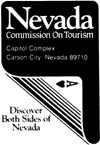Nevada is
blessed with a number of regional and local museums that are
wonderful cache houses of the state's rich historic past. One of
the best is the Churchill County Museum in Fallon.
Created in 1968, the 10,000 square foot museum is an impressive
storehouse of artifacts detailing the development and history of
Churchill County. It is a credit to director Sharon Taylor and the
people of Fallon that the museum provides such a complete picture.
Historians have long known the Fallon area is an important nexus
in man's development in the West. Before the arrival of settlers,
Native American people resided around the marshes and giant inland
sea that once covered the area.
One of the best exhibits at the museum is a detailed display about
Hidden Cave, an archaeological site with a 21,000-year
stratigraphy (meaning that scientists can trace soil samples and
fossils dating over that many years).
Free tours to Hidden Cave, located about 12 miles from Fallon, are
offered through the museum on the second and fourth Saturday of
each month at 9:30 a.m.
Additionally, the museum offers exhibits showing later area
developments. There are good displays of Indian artifacts and one
exhibit includes the remains of a covered wagon and other items
used by settlers traveling on the Emigrant Trail through the
nearby Forty Mile Desert (the most hazardous part of the trail).
Fallon is also located on the famed Pony Express Trail. The
Overland Telegraph replaced the Pony Express riders and followed
the same route. One exhibit describes the history of communication
in the West and notes that the Overland Telegraph was eventually
incorporated into the Churchill County Telephone and Telegraph
System, the nation's only county-owned and maintained telephone
system (the museum sells souvenir glass telephone insulators that
were once part of the system).
The museum also contains a display telling the history of the
Newlands Water Project, the nation's first federal reclamation
project in 1902. This irrigation system created the nearby
Lahontan Reservoir and provides water for area farmers.
Outside the museum building, you can also find a number of unique
displays that further illustrate the area's history.
For example, there are samples of ancient Indian petroglyphs (rock
writings) and the restored Woodliff Novelty Store, once a
well-known Fallon business that served the local community over a
century ago.
Reflecting the area's abundant agricultural roots, there is also a
large collection of farming equipment, including a 1903 Case Steam
Traction engine.
The museum has a small gift shop that offers one of the most
complete collections of historic books about Nevada.
To reach the museum, drive east of Carson City for about an hour
on Highway 50. Once in Fallon, turn right on Maine Street (it
really should be called Main Street, but they like to do things a
little differently in Fallon) and you'll find the museum at 1050
So. Maine St.
Of course, besides the museum, another reason to visit Fallon is
to pick up some of the region's renowned produce. Fallon is the
home of the Hearts of Gold cantaloupe, one of the juiciest and
tastiest melons ever grown. Several local produce stores offer the
Hearts of Gold in season (generally late summer), including
Workman's Produce on Highway 50.
Fallon celebrates its famous melons each year during the
Cantaloupe Festival, held each Labor Day weekend.
While driving through Fallon, also take note of the old Churchill
County Courthouse, located at the intersection of Highway 50 and
Maine Street. The building, constructed in 1903, was the last
wooden courthouse still used in Nevada until the county offices
moved in 1998.
The Churchill County Museum and Archives is open six days a week
(closed Thursday). For more information call 702-423-3677.
Photographs and
articles courtesy of
